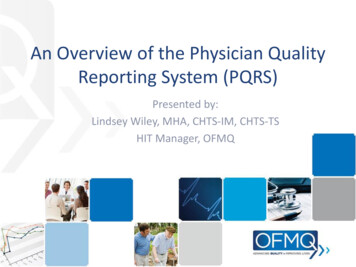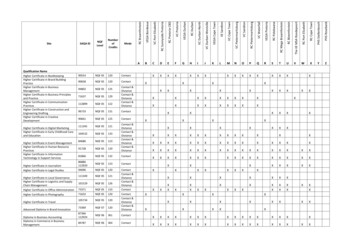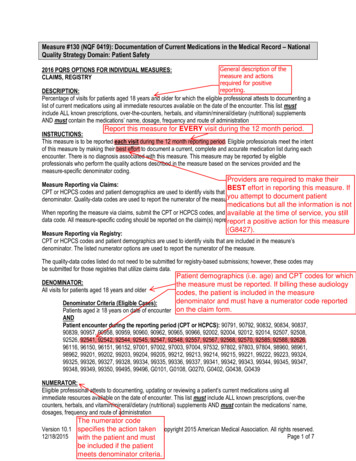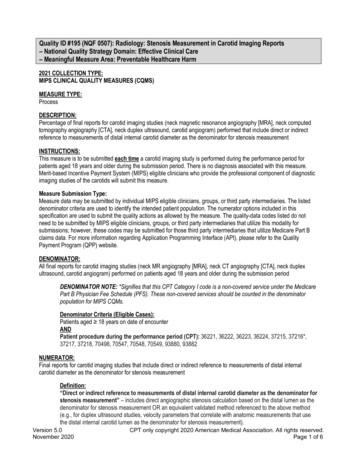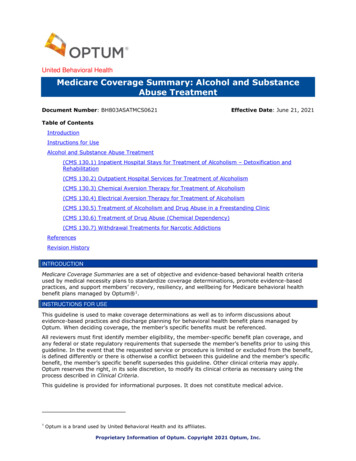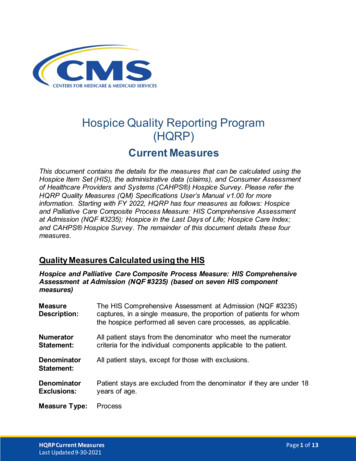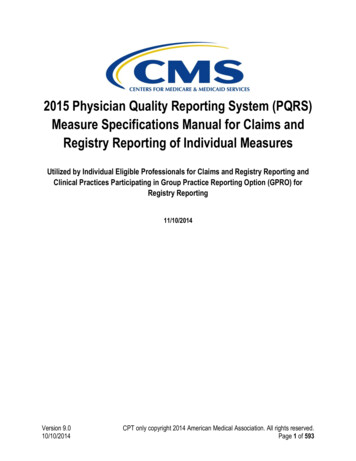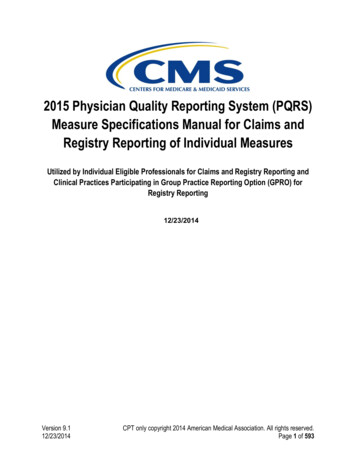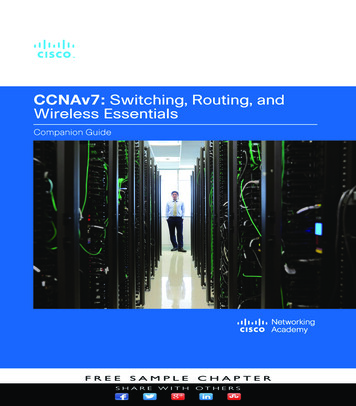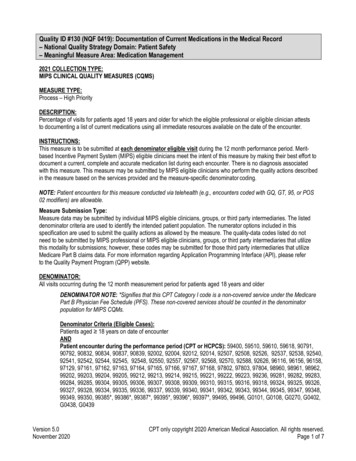
Transcription
Quality ID #130 (NQF 0419): Documentation of Current Medications in the Medical Record– National Quality Strategy Domain: Patient Safety– Meaningful Measure Area: Medication Management2021 COLLECTION TYPE:MIPS CLINICAL QUALITY MEASURES (CQMS)MEASURE TYPE:Process – High PriorityDESCRIPTION:Percentage of visits for patients aged 18 years and older for which the eligible professional or eligible clinician atteststo documenting a list of current medications using all immediate resources available on the date of the encounter.INSTRUCTIONS:This measure is to be submitted at each denominator eligible visit during the 12 month performance period. Meritbased Incentive Payment System (MIPS) eligible clinicians meet the intent of this measure by making their best effort todocument a current, complete and accurate medication list during each encounter. There is no diagnosis associatedwith this measure. This measure may be submitted by MIPS eligible clinicians who perform the quality actions describedin the measure based on the services provided and the measure-specific denominator coding.NOTE: Patient encounters for this measure conducted via telehealth (e.g., encounters coded with GQ, GT, 95, or POS02 modifiers) are allowable.Measure Submission Type:Measure data may be submitted by individual MIPS eligible clinicians, groups, or third party intermediaries. The listeddenominator criteria are used to identify the intended patient population. The numerator options included in thisspecification are used to submit the quality actions as allowed by the measure. The quality-data codes listed do notneed to be submitted by MIPS professional or MIPS eligible clinicians, groups, or third party intermediaries that utilizethis modality for submissions; however, these codes may be submitted for those third party intermediaries that utilizeMedicare Part B claims data. For more information regarding Application Programming Interface (API), please referto the Quality Payment Program (QPP) website.DENOMINATOR:All visits occurring during the 12 month measurement period for patients aged 18 years and olderDENOMINATOR NOTE: *Signifies that this CPT Category I code is a non-covered service under the MedicarePart B Physician Fee Schedule (PFS). These non-covered services should be counted in the denominatorpopulation for MIPS CQMs.Denominator Criteria (Eligible Cases):Patients aged 18 years on date of encounterANDPatient encounter during the performance period (CPT or HCPCS): 59400, 59510, 59610, 59618, 90791,90792, 90832, 90834, 90837, 90839, 92002, 92004, 92012, 92014, 92507, 92508, 92526, 92537, 92538, 92540,92541, 92542, 92544, 92545, 92548, 92550, 92557, 92567, 92568, 92570, 92588, 92626, 96116, 96156, 96158,97129, 97161, 97162, 97163, 97164, 97165, 97166, 97167, 97168, 97802, 97803, 97804, 98960, 98961, 98962,99202, 99203, 99204, 99205, 99212, 99213, 99214, 99215, 99221, 99222, 99223, 99236, 99281, 99282, 99283,99284, 99285, 99304, 99305, 99306, 99307, 99308, 99309, 99310, 99315, 99316, 99318, 99324, 99325, 99326,99327, 99328, 99334, 99335, 99336, 99337, 99339, 99340, 99341, 99342, 99343, 99344, 99345, 99347, 99348,99349, 99350, 99385*, 99386*, 99387*, 99395*, 99396*, 99397*, 99495, 99496, G0101, G0108, G0270, G0402,G0438, G0439Version 5.0November 2020CPT only copyright 2020 American Medical Association. All rights reserved.Page 1 of 7
NUMERATOR:Eligible professional or eligible clinician attests to documenting, updating or reviewing the patient’s currentmedications using all immediate resources available on the date of the encounter.Definitions:Current Medications – Medications the patient is presently taking including all prescriptions, over-thecounters, herbals and vitamin/mineral/dietary (nutritional) supplements with each medication’s name, dosage,frequency and administered route.Route – Documentation of the way the medication enters the body (some examples include but are not limitedto: oral, sublingual, subcutaneous injections, and/or topical).Not Eligible (Denominator Exception) – A patient is not eligible if there is documentation of a medicalreason(s) for not documenting, updating, or reviewing the patient’s current medications list (e.g., patient is inan urgent or emergent medical situation where time is of the essence and to delay treatment would jeopardizethe patient's health status).NUMERATOR NOTE: The MIPS eligible clinician must document in the medical record they obtained,updated, or reviewed a medication list on the date of the encounter. MIPS professional or MIPS eligibleclinicians submitting this measure may document medication information received from the patient,authorized representative(s), caregiver(s) or other available healthcare resources.This list must include ALL known prescriptions, over-the-counter (OTC) products, herbals, vitamins,minerals, dietary (nutritional) supplements AND must contain the medications' name, dosage, frequency androute of administration.By submitting the action described in this measure, the provider attests to having documented a list ofcurrent medications utilizing all immediate resources available at the time of the encounter. G8427 should besubmitted if the MIPS eligible clinician documented that the patient is not currently taking any medications.Numerator Options:Performance Met:OROREligible clinician attests to documenting in the medicalrecord they obtained, updated, or reviewed the patient’scurrent medications (G8427)Denominator Exception:Documentation of a medical reason(s) for notdocumenting, updating, or reviewing the patient’scurrent medications list (e.g., patient is in an urgent oremergent medical situation) (G8430)Performance Not Met:Current list of medications not documented as obtained,updated, or reviewed by the eligible clinician, reason notgiven (G8428)RATIONALE:According to the National Center for Health Statistics, during the years of 2011-2014, 46.9 percent of patients (bothmale and female) were prescribed at least one prescription medication with 10.9 percent taking 5 or moremedications. Additionally, 90.6 percent of patients (both male and female) aged 65 years and older were prescribedat least one medication with 40.7 percent taking 5 or more medications (2017). In this context, maintaining anaccurate and complete medication list has proven to be a challenging documentation endeavor for various healthcare provider settings. While most of outpatient encounters (2/3) result in providers prescribing at least onemedication, hospitals have been the focus of medication safety efforts (Stock, Scott, & Gurtel, 2009). Nassaralla,Naessens, Chaudhry, Hansen, and Scheitel (2007) caution that this is at odds with the current trend, where patientswith chronic illnesses are increasingly being treated in the outpatient setting and require careful monitoring of multiplemedications. Additionally, Nassaralla et al. (2007) reveal that it is in fact in outpatient settings where more fatalVersion 5.0CPT only copyright 2020 American Medical Association. All rights reserved.November 2020Page 2 of 7
adverse drug events (ADE) occur when these are compared to those occurring in hospitals (1 of 131 outpatientdeaths compared to 1 in 854 inpatient deaths). In the outpatient setting, ADEs occur 25% of the time and over onethird of these are considered preventable (Tache, Sonnichsen, & Ashcroft, 2011). Particularly vulnerable are patientsover 65 years, with evidence suggesting that the rate of ADEs per 10,000 person per year increases with age; 25-44years old at 1.3; 45-64 at 2.2, and 65 at 3.8 (Sarkar, López, & Maselli, 2011). Another vulnerable group arechronically ill individuals. These population groups are more likely to experience ADEs and subsequenthospitalization.A multiplicity of providers and inadequate care coordination among them has been identified as barriers to collectingcomplete and reliable medication records. Data indicate that reconciliation and documentation continue to be poorlyexecuted with discrepancies occurring in 92% (74 of 80 patients) of medication lists among admittance to theemergency room. Of 80 patients included in the study, the home medications were re ordered for 65% of patients ontheir admission and of the 65% the majority (29%) had a change in their dosing interval, while 23% had a change intheir route of administration, and 13% had a change in dose. A total of 361 medication discrepancies, or the differencebetween the medications patients were taking before admission and those listed in their admission orders, wereidentified in at least 74 patients (Penumarthi et al., 2015). The study found that “Through an appropriate reconciliationprogramme, around 80% of errors relating to medication and the potential harm caused by these errors could bereduced” (Penumarthi et al., 2015, p. 243).Documentation of current medications in the medical record facilitates the process of medication review andreconciliation by the provider, which is necessary for reducing ADEs and promoting medication safety. The need forprovider to provider coordination regarding medication records, and the existing gap in implementation, is highlighted inthe American Medical Association’s Physician’s Role in Medication Reconciliation, which states that "critical patientinformation, including medical and medication histories, current medications the patient is receiving and taking, andsources of medications, is essential to the delivery of safe medical care. However, interruptions in the continuity of careand information gaps in patient health records are common and significantly affect patient outcomes" (2007, p.7). Thisis because clinical decisions based on information that is incomplete and/or inaccurate are likely to lead to medicationerror and ADEs. Weeks, Corbette, & Stream (2010) noted similar barriers and identified the utilization of healthinformation technology as an opportunity for facilitating the creation of universal medication lists.One 2015 meta-analysis showed an association between EHR documentation with an overall RR of 0.46 (95% CI 0.38 to 0.55; P 0.001) and ADEs with an overall RR of 0.66 (95% CI 0.44 to 0.99; P 0.045). This meta-analysisprovides evidence that the use of the EHR can improve the quality of healthcare delivered to patients by reducingmedication errors and ADEs (Campanella et al., 2016).CLINICAL RECOMMENDATION STATEMENTS:The Joint Commission's 2019 Ambulatory Health Care National Patient Safety Goals guide providers to maintain andcommunicate accurate patient medication information. Specifically, the section "Use Medicines Safely NPSG.03.06.01"states the following: "Record and pass along correct information about a patient’s medicines. Find out what medicinesthe patient is taking. Compare those medicines to new medicines given to the patient. Make sure the patient knowswhich medicines to take when they are at home. Tell the patient it is important to bring their up-to-date list of medicinesevery time they visit a doctor.”The National Quality Forum's Safe Practices for Better Healthcare - 2010 Update, states the following: “the healthcareorganization must develop, reconcile, and communicate an accurate patient medication list throughout the continuumof care” (p. 40).COPYRIGHT:These performance measures are not clinical guidelines and do not establish a standard of medical care, and havenot been tested for all potential applications.THE MEASURES AND SPECIFICATIONS ARE PROVIDED “AS IS” WITHOUT WARRANTY OF ANY KIND.Limited proprietary coding is contained in the measure specifications for convenience. Users of the proprietary codeVersion 5.0November 2020CPT only copyright 2020 American Medical Association. All rights reserved.Page 3 of 7
sets should obtain all necessary licenses from the owners of these code sets. PCPI disclaims all liability for use oraccuracy of any Current Procedural Terminology (CPT ) or other coding contained in the specifications.CPT contained in the Measure specifications is copyright 2004-2020 American Medical Association. LOINC iscopyright 2004-2020 Regenstrief Institute, Inc. This material contains SNOMED Clinical Terms (SNOMED CT )copyright 2004-2020 International Health Terminology Standards Development Organisation. ICD-10 is copyright 2020World Health Organization. All Rights Reserved.Version 5.0November 2020CPT only copyright 2020 American Medical Association. All rights reserved.Page 4 of 7
2021 Clinical Quality Measure Flow for Quality ID #130 (NQF 0419):Documentation of Current Medications in the Medical RecordDisclaimer: Refer to the measure specification for specific coding and instructions to submit this measure.StartDenominatorNoNot included in EligiblePopulation/DenominatorNoNumeratorPatients aged 18 years on date ofencounterEligibleclinician attests todocumenting in the medicalrecord they obtained, updated,or reviewed the patient’scurrent medicationsYesData Completeness Met Performance MetG8427 or equivalent(40 visits)aYesNoPatientencounter duringthe performance periodas listed inDenominator*Documentationof a medical reason(s) fornot documenting, updating, orreviewing the patient’scurrent medicationslistYesData Completeness Met Denominator ExceptionG8430 or equivalent(10 visits)bYesNoInclude in EligiblePopulation/Denominator(80 visits)dCurrent listof medications notdocumented as obtained,updated, or reviewed by theeligible clinician,reason notgivenYesData Completeness Met Performance Not MetG8428 or equivalent(20 visits)cNoData Completeness Not MetQuality Data Code orequivalent not submitted(10 visits)SAMPLE CALCULATIONSData Completeness Performance Met (a 40 visits) Denominator Exception (b 10 visits) Performance Not Met (c 20 visits) 70 visits 87.50%Eligible Population / Denominator (d 80 visits) 80 visitsPerformance Rate Performance Met (a 40 visits)Data Completeness Numerator (70 visits) – Denominator Exception (b 10 visits) 40 visits 66.67%60 visits*See the posted measure specification for specific coding and instructions to submit this measure.NOTE: Submission Frequency: VisitCPT only copyright 2020 American Medical Association. All rights reserved.The measure diagrams were developed by CMS as a supplemental resource to beused in conjunction with the measure specifications. They should not be usedalone or as a substitution for the measure specification.v5Version 5.0November 2020CPT only copyright 2020 American Medical Association. All rights reserved.Page 5 of 7
2021 Clinical Quality Measure Flow Narrative For Quality ID #130 (NQF 0419):Documentation of Current Medications in the Medical RecordDisclaimer: Refer to the measure specification for specific coding and instructions to submit this measure.1. Start with Denominator2. Check Patients aged greater than or equal to 18 years on date of encounter:a. If Patients aged greater than or equal to 18 years on date of encounter equals No, do not include in EligiblePopulation/Denominator. Stop processing.b. If Patients aged greater than or equal to 18 years on date of encounter equals Yes, proceed to check Patientencounter during the performance period as listed in Denominator*.3. Check Patient encounter during the performance period as listed in Denominator*:a. If Patient encounter during the performance period as listed in Denominator* equals No, do not include inEligible Population/Denominator. Stop processing.b. If Patient encounter during the performance period as listed in Denominator* equals Yes, include in EligiblePopulation/Denominator.4. Denominator Population:a. Denominator Population is all Eligible Visits in the Denominator. Denominator is represented as Denominatorin the Sample Calculation listed at the end of this document. Letter d equals 80 visits in the SampleCalculation.5. Start Numerator6. Check Eligible clinician attests to documenting in the medical record they obtained, updated, or reviewed thepatient’s current medications:a. If Eligible clinician attests to documenting in the medical record they obtained, updated, or reviewed thepatient’s current medications equals Yes, include in Data Completeness Met and Performance Met. Data Completeness Met and Performance Met letter is represented as Data Completeness andPerformance Rate in the Sample Calculation listed at the end of this document. Letter a equals 40 visitsin the Sample Calculation.b. If Eligible clinician attests to documenting in the medical record they obtained, updated, or reviewed thepatient’s current medications equals No, proceed to check Documentation of a medical reason(s) for notdocumenting, updating, or reviewing the patient’s current medications list.7. Check Documentation of a medical reason(s) for not documenting, updating, or reviewing the patient’s currentmedications list:a. If Documentation of a medical reason(s) for not documenting, updating, or reviewing the patient’s currentmedications list equals Yes, include in Data Completeness Met and Denominator Exception. Data Completeness Met and Denominator Exception letter is represented as Data Completeness andPerformance Rate in the Sample Calculation listed at the end of this document. Letter b equals 10 visitsin the Sample Calculation.b. If Documentation of a medical reason(s) for not documenting, updating, or reviewing the patient’s currentVersion 5.0November 2020CPT only copyright 2020 American Medical Association. All rights reserved.Page 6 of 7
medications list equals No, proceed to check Current list of medications not documented as obtained, updated,or reviewed by the eligible clinician, reason not given.8. Check Current list of medications not documented as obtained, updated, or reviewed by the eligible clinician,reason not given:a. If Current list of medications not documented as obtained, updated, or reviewed by the eligible clinician, reasonnot given equals Yes, include in Data Completeness Met and Performance Not Met. Data Completeness Met and Performance Not Met letter is represented as Data Completeness in theSample Calculation listed at the end of this document. Letter c equals 20 visits in the Sample Calculationb. If Current list of medications not documented as obtained, updated, or reviewed by the eligible clinician, reasonnot given equals No, proceed to check Data Completeness Not Met.9. Check Data Completeness Not Met:a. If Data Completeness Not Met, the Quality Data Code or equivalent was not submitted. 10 visits have beensubtracted from the Data Completeness Numerator in the Sample Calculation.Sample Calculations:Data Completeness equals Performance Met (a equals 40 visits) plus Denominator Exception (b equals 10 visits) plusPerformance Not Met (c equals 20 visits) divided by Eligible Population / Denominator (d equals 80 visits). All equals 70 visitsdivided by 80 visits. All equals 87.50 percent.Performance Rate equals Performance Met (a equals 40 visits) divided by Data Completeness Numerator (70 visits) minusDenominator Exception (b equals 10 visits). All equals 40 visits divided by 60 visits. All equals 66.67 percent.*See the posted measure specification for specific coding and instructions to submit this measure.NOTE: Submission Frequency: VisitThe measure diagrams were developed by CMS as a supplemental resource to be used in conjunction with the measure specifications. They should notbe used alone or as a substitution for the measure specification.Version 5.0November 2020CPT only copyright 2020 American Medical Association. All rights reserved.Page 7 of 7
with this measure. This measure may be submitted by MIPS eligible clinicians who perform the quality actions described in the measure based on the services provided and the measure-specific denominator coding. NOTE: Patient encounters for this measure conducted via telehealth (e.g., encounters coded with GQ, GT, 95, or POS

